
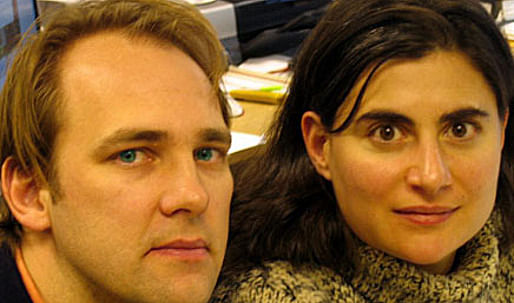
The one thing you will not find in school--or even on Architecture Registration Exams--is a course on how to get work, yet it is one of the most basic needs of any design practice. In fact, if you don't have an equal ability to experiment in getting work as you do in doing work you would be fortunate to make it past the first five years.
UpStarts is a series of features on the foundations of contemporary practice. It will have a global reach in which practices from Europe, North America, Asia, and beyond will be asked to address the work behind getting the work, and the effect of cultural contexts. The focus will be on how a practice is initiated and maintained. In many ways, the critical years of a fledgling design partnership is within the initial five years, after the haze and daze of getting it off the ground. UpStarts will survey the first years of practice as a tool for tracking the tactics of the rapidly evolving methods for sustaining a practice.
This UpStarts feature looks at the post-OMA practice of WORKac 's Amale Andraos and Dan Wood, who have proven that in architecture one can not rely on pedigree alone. When this husband and wife partnership started their own design firm in 2002, they created a 5-Year Plan that allowed them to build on their previous experiences while developing a personal voice and remaining financially viable. Amale Andraos and Dan Wood spoke with me via telephone from their New York City office.
Quilian Riano: Hi Amale, Dan, let us start by having you describe your 5-Year Plan and telling us why you developed it.
Amale Andraos: The 5-Year Plan was simple: Say YES to everything. We developed it because we wanted to be open, as we started without a preconceived set of 'theories' we wanted to test. We wanted to simply begin working and allow things to develop.
Dan Wood: Right, we were coming out of a big office with a strong personality and we had been there for a long time. We were not sure anymore what was truly us and what was the office.
AA: From the start we were very committed to practice, it was not until later that we fell into academia.
DW: That was one of the 'accidents'.
QR: You mean one of the accidents that came about because of the 5-Year Plan?
AA: Correct, we could not say no to anything, even to academia.
QR: So the 5-Year Plan extended beyond purely architectural work, if anyone called with any proposition related to the field you would have said yes?
DW: To everything except to go work for them, but we never got that call.
AA: Someone did, however, try to buy us out.
DW/AA: We said no promptly
QR: So you do say no sometimes!
DW: Well, we are coming up on the end of the 5-Year Plan and now we are working on the next 5-year plan, which can be described as: "say no to a few things."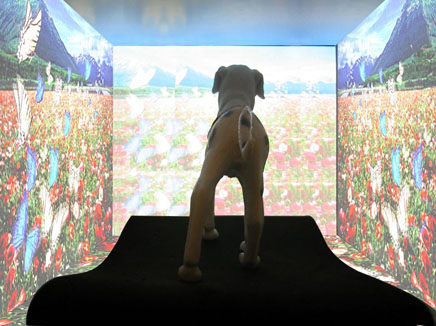
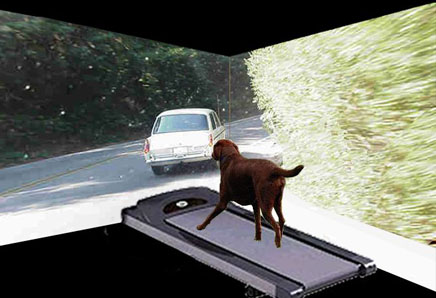

Villa Pup: Urban Dog House. New York City, NY. Courtesy of WORKac
QR: What would you consider the worst experience you had saying yes to everything with the say 5-Year Plan?
DW: We took on a job in which we were the executive architects for a developer whose partner had studied architecture at one point. We spent most of our time trying to solve problems for a project that, quite frankly, we could not imagine anyone would want to build and something that we would never have designed.
AA: NEVER!
DW: Even using a word like 'aesthetics' for that project is already too much of a stretch. They even had this bordello-themed conference room with padded red-velvet. Anyway, we got blamed for every single problem, including the aesthetics, even though it was completely out of our control.
QR: Sounds like a nightmare, what was the most rewarding and unexpected thing you got to work on because of the 5-Year Plan?
DW: The classic for us, I think, is the doghouse.
AA: I think it was not so much about a specific project but all the things we experienced by being open to any and all projects. For example, We were contacted by a very young developer in Panama, had we had more experience we would have realized he was in over his head at that moment in time, however we got to see how things get done in Panama. We took all projects very seriously.
DW: That is what made a project like the doghouse so much fun. We wanted to be serious urbanists and we get a call for a doghouse, so we took it as a serious exercise to design a house for the active, urban dog.

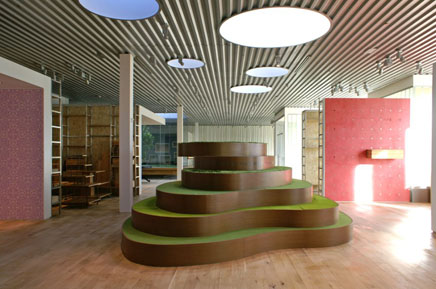
Anthropologie Dos Lagos. Corona, CA. Courtesy of WORKac
QR: What about the project for the chain store Anthropologie you are doing out in the suburbs? that does not seem like the type of project architects usually take on.
DW: We started working with them because they came to us, at first it was a bit of a shock as their product and current stores are very different to what we do. However, this publicly traded company felt they are doing well now but with imitators starting to come up it was the right time for a new vision for them to stay on the lead.
But after the initial shock the issue became how to work nowhere; the site was outside the suburbs and really even the exurbs. When we went out for a site visit not only was the shopping mall under construction but so was the community it was going to serve.
AA: It is important to point out that in the area there is also a bridge that SCI-Arc students have designed. One can only hope that these efforts by designers, in this case the bridge and the store, can lead to people questioning the current suburban pitch roof hegemony and, maybe even, the need a car, how their house can become greener, etc...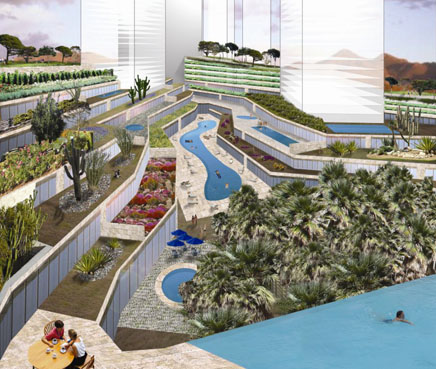
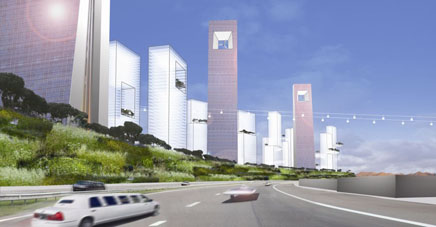
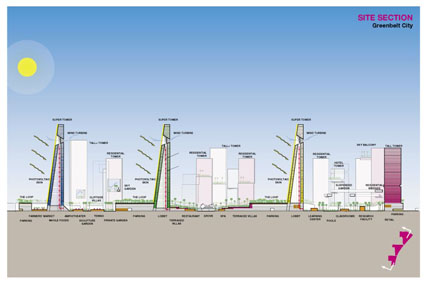
Greenbelt City. Las Vegas, NV. Courtesy of WORKac
QR: Amale what you just said leads me to a couple of related questions, first what is the Ecourbanism you have been working on? Secondly I am interested in talking the role that nature plays in your work?
DW: To answer your first question, Ecourbanism is a theory we put forth a few years ago that we are still testing and researching. Basically, we are interested in density and cities and in ecological design, mostly because there are very few good examples of it. We thought that an interesting approach for ecology is to take advantage of efficiencies that can be achieved only at an urban scale. Also, we couple that with using ecological design in a visual way, that by exposing it, we can further the cause of design and make people more aware of sustainability issues. Structural expressionism has reached is apotheosis and perhaps it is time to use mechanical systems and sustainable technologies as a base for design.
AA: There were great visions for the city in the 60's and 70's.
DW: We also had more ecological vision then.
AA: Exactly, but then that way of thinking stopped and we were left with the cookie-cutter neighborhoods we now live in. You could not be utopic anymore, we are interested in bringing back the naïveté of those utopian ideas. Places like Dubai can be criticized for their current social and environmental impacts, but their potential lies in that they are closed design systems in which one can experiment with new environmental and social modes of living.
DW: The Greenbelt City in Las Vegas was our first foray into eco-design because it was a large site and it was a completely enclosed system of 15,000 apartments on 100 acres, built on phases but under one master plan. We felt this was a perfect opportunity to think about some of these scale issues.
AA: There are obviously other developments that are doing this interestingly, like BedZed, the live-work community in England, and Arup's Dongtan in China. So it is starting and it will be interesting where these go, but what we are interested in is how these developments express their ecological intentions.
DW: We are still researching it and teaching it at Princeton and hopefully we will bring it all into a book within a year.
QR: What about the use of nature in your work?
AA: About nature: What is natural anymore? Everything is constructed, so when we deal with so called nature we are comfortable making it plain that it is a construction. We were just at Philip Johnson's Glass House and you look out and the landscape looks wild but it is a complete construction. We play off of that, this kind of awareness. So when we let vines grow in front of Anthropologie we design their growth pattern to perform, to indicate entrances, to create edges between zones, etc…
DW: I think we are also interested in the confrontation with nature, while using it as a constructed element using its power. That, I think, is one of the powers of Anthropologie that you are faced with nature in the last place you expect it. When it rains in the courtyard for example, it is a confrontation; you have rain inside your suburban shopping mall.
QR: In those type of stores you usually hardly even have natural light!
DW: That's right
AA: Once again, it is about confronting people to question their modes of living.
DW: And in our Greenbelt City project all the nature is there to perform. For example, we covered the top of the parking garage loop with a layer of nature, but through design we hope to make it evident that nature is there because we are using the wastewater from 15,000 residents. Finally, for us nature still represents the real even though it is constructed.
QR: What do you mean 'the real'?
DW: The primordial.
AA: Nature for us means showing how things function and by that heightening the experience. It is all about experience.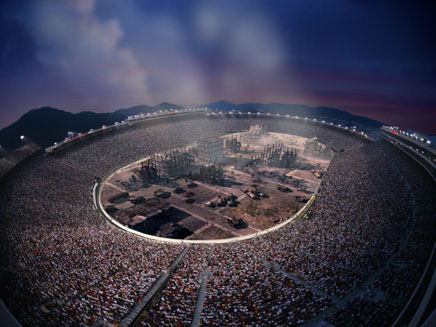
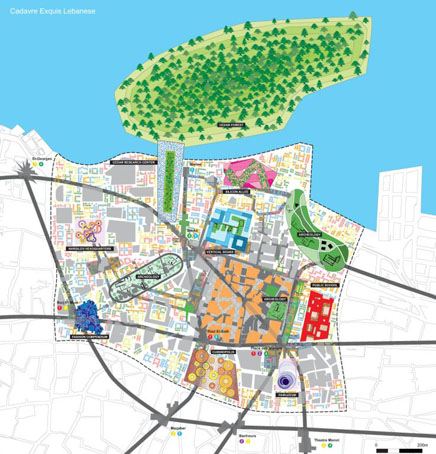
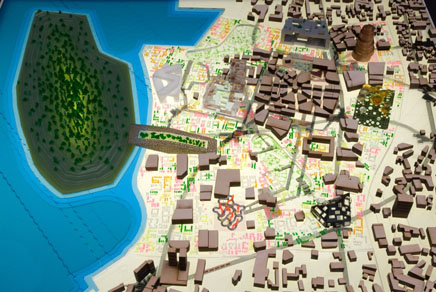
Cadavre Exquis Lebanese. Beirut, Lebanon. Courtesy of WORKac
QR: Let's go back to this notion of bringing back utopian thinking in architecture, specially in the context of your work constantly being referred to as 'fun' or 'witty'.
AA: It is about the possibility of imagining new worlds and modes of living. Never stopping to question what people like, you know, possibilities. The utopian projects had ambitions we don't see anymore, even if they had downfalls, being able to think at that level is critical. The wittiness and lightness is a way for us to show awareness, a wink if you will.
DW: It also feels like THIS is the time. That is partly why we are interested in ecology because it is an appropriate thing to think about in terms of the future.
AA: But, not only ecology; politics and social issues are also important since architecture is so involved at all these levels. Everything we do is involved with structures of power the key is to be able to find ways to be critical within these forces, not just to become just corporate.
DW: You are right that there is a heroic utopian streak though our work, and it is hard to even admit, but then again I feel: Why don't more people admit it?
AA: There has been so much critique of the utopian movements and we are stuck there.
QR: I have a final question about your practice, how has it been practicing as both partners and a couple?
AA: I don't really think is any different from working in any type of partnership. You have to make sure you are able to work together and we have been lucky to find that we actually enjoy working together at a partnership level. Given that we work all the time I think it is exciting that we can design and work off of each other's ideas.
DW: Among the most exciting and unexpected things we found is that professionally people do not assume we are not a couple. We have had clients and even employees that did not realize we were a couple. Not that we down-play it, or up-play it for that matter, we just let it come up naturally.
AA: Yes, if we get questions sometimes they are from prospective clients and then they want to know what each of us does within the practice. But we refuse to play that game as we may play many roles at different times in any and all projects. If we put ourselves in a neat box from the beginning we lose power.
QR: Amale, if I may, how do you think the partnership works for you as a woman in a field that has at times been known to be unfriendly towards women.
AA: Sometimes you may have an awkward first few minutes, but once contractors and clients notice you are not stupid you can move forward to have a productive relationship. I would go as far as saying that contractors listen more to me than they do to Dan. Frankly, I sense that academia has more gender-bias issues than the profession does.
QR: That is all I have, would you like to leave us with anything else?
AA: Since this is about starting up, I would say that exposure and experience is very critical. Even with students you feel like you should have read so much and done so much, and of course you should have, but it is important to realize that it is a process of going back and forward. Being able to suspend judgment and produce is critical.
DW: You will have bad projects and even from those you will learn a lot. I do not wish we had not gone through any of the experiences we have had. We just did an exhibition called 'The 5-Year Plan' and realized that we did 105 projects in the last four and half years.
AA: As they say, 'whatever doesn't kill you makes you stronger'. In a way you learn more from the bad projects and experiences than you do from the good ones.
QR: Amale, Dan, thanks a lot for taking to us and good luck with the next five years.
Creative Commons License
This work is licensed under a Creative Commons License .
/Creative Commons License
Pratt Institute DeanDSGN AGNC founder Quilian (pronounced: Killian) is the Dean of Pratt Institute’s School of Architecture, working across the school’s architecture, landscape, urban design, planning, and management programs. Quilian also serves as the Vice President for Architecture ...
6 Comments
Q,
Wasn't there an article in the recent Metropolis Mag about them???
Yes Nama,
On the Cusp
(I was already working on getting this feature done when the article came out)
How did you meet them?
Through friends?
I mean what made you pick them originally to interview?
I met Amale and Dan at the GSD, I chose to interview them for UpStarts because of their 5-Year Plan. It seemed like an interesting way of formally thinking of what most beginning firms do anyway and an appropriate addition to the UpStarts series.
i see they've adopted my instant icon concept of the big shiny building with a hole in it. also, dig the homage to astro on the treadmill. jane stop this crazy thing....
Can't wait to see them here at USC in November. :o)
Block this user
Are you sure you want to block this user and hide all related comments throughout the site?
Archinect
This is your first comment on Archinect. Your comment will be visible once approved.